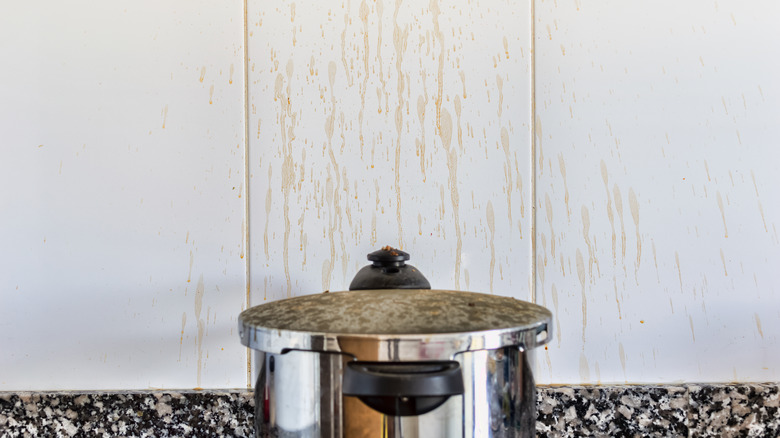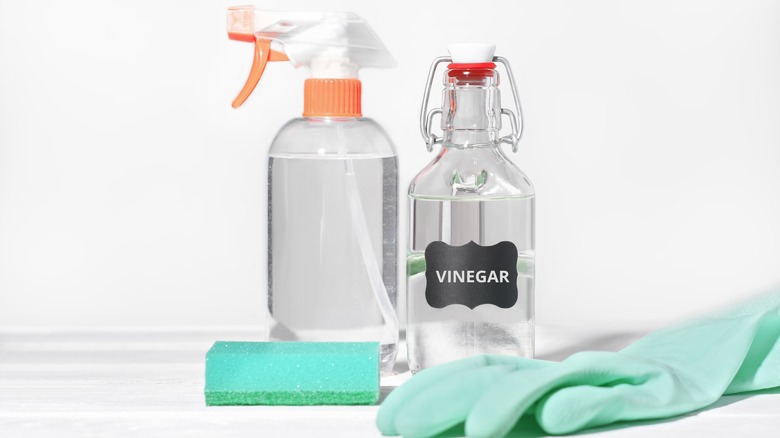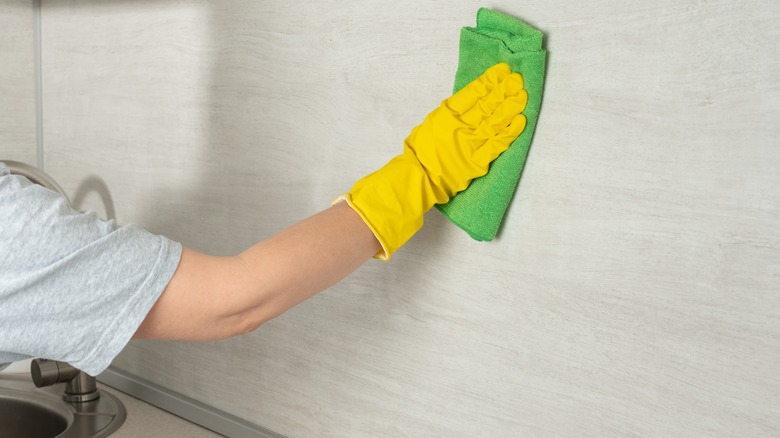Things To Avoid When Cleaning Your Kitchen Walls Of Food Splatter
There's nothing worse than messy kitchen spills that seem to instantly reach every nearby surface. While the spill likely centers on the floor, you may soon notice that the cabinets, appliances, and walls have splatters. In the case of walls, food splatters may span from top to bottom but before you grab the nearest cleaner and rag, there are some things you should avoid when cleaning them. Though it may seem counterintuitive, don't immediately reach for water or vinegar without first thinking about your wall's finish.
Kitchen walls come in various finishes and each requires a slightly different cleaning approach. Most kitchens have painted walls, and luckily, most are fairly resilient and can be cleaned with gentle solutions. However, it's crucial to determine the paint's sheen since this affects how much scrubbing you can do. If you have wallpaper, you'll need a more delicate cleaning approach, mild cleaning solutions, and no scrubbing which could tear it. Ceramic and porcelain tiles are hardy, non-porous surfaces and can easily handle stronger cleaning solutions and scrubbing without damage.
Don't use vinegar on certain finishes
Food splatters should not be put off until you deep clean your kitchen, but cleaned immediately instead so stains don't set in. While it's tempting to grab the nearest cleaner or disinfectant to avoid stains, some cleaners can do more harm than good. Additionally, some types of paint may come right off with a good scrub when using certain chemicals or even natural solutions. Flat and eggshell finishes especially require a gentle touch. In general, glossy enamel paints can put up with the most in terms of washing and maintaining its finish. This is one of the reasons why choosing the right finish of paint for your house is important.
A natural vinegar solution made of two parts water and one part vinegar, which for many is a go-to natural cleaner, can end up damaging walls that have flat, satin, and eggshell finishes. Yet, a DIY vinegar cleaner would likely work just fine for semi-gloss, gloss, and oil paints.
Additionally, you'll also want to avoid vinegar if you have stainless steel or unfinished wood areas on your walls. The acid can discolor the steel. Vinegar can also damage unfinished wood because it can seep into it and warp it. It should only be used on sealed wood finishes.
Be careful using water
Believe it or not, though water may be the purest form of cleansing, it can damage your walls if you use too much. Soaking wet walls can be a recipe for disaster, potentially damaging paint or wallpaper. Excess water can also drip down the wall and leave water marks. On wallpaper, it can soak through so always use a thoroughly wrung-out sponge when using soap and water to clean it, and then dry the wall with a soft cloth.
An alternative that has a bit of gentle abrasiveness is a baking soda paste made from baking soda and a little water, which is especially good for removing grease on tiles. For flat paint, use a soft sponge and water. Glossy paint can handle some hot water and possibly a bit of all-purpose cleaner, while latex paint can withstand most multipurpose cleaners.
You also want to use the proper cleaning tools. Scratchy cloths, steel wool, or abrasive scouring pads can ruin your walls. Stick to microfiber cloths and even damp soft sponges. Always wring out your cleaning tools until they're damp, not dripping. No matter which cleaner or cleaning tool you use, always do a spot test in an inconspicuous area of the wall before applying any cleaning solution to ensure it won't cause any discoloration or damage.


